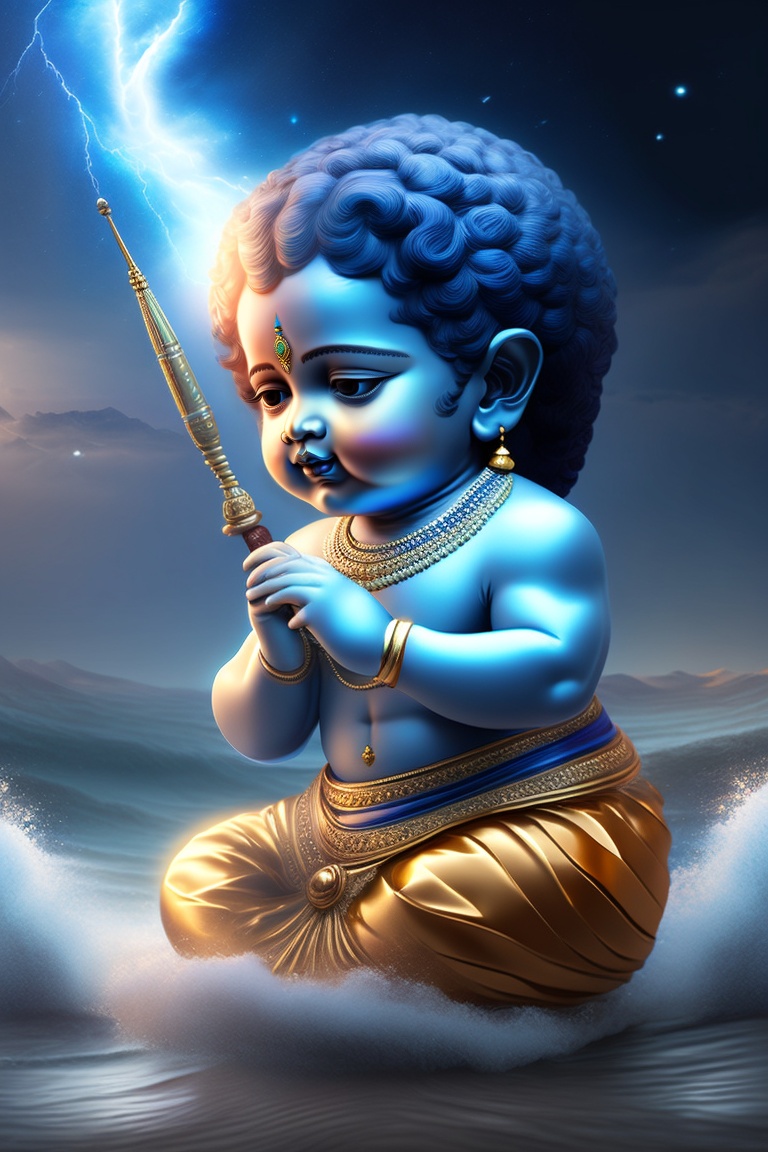Part Two: Krishna's Early Life and Childhood (Ages 0-12)
Part Two: Krishna's Early Life and Childhood (Ages 0-12)
The early life and childhood of Lord Krishna, from his birth until the age of 12, are filled with enchanting tales, divine exploits, and valuable life lessons. Krishna, growing up in the idyllic village of Gokul, captured the hearts of the villagers and left an indelible mark on their lives. Let us delve into the captivating stories and teachings from this significant phase of Krishna's life.
Krishna, known for his mischievous and playful nature, endeared himself to everyone in Gokul. His enchanting smile, melodious flute playing, and charismatic personality were irresistible. As a child, Krishna displayed extraordinary qualities and divine powers, which became evident through various incidents.
One of the most famous stories from Krishna's childhood is the episode of his stealing butter. Krishna, fondly called "Maakhan Chor" or the butter thief, had an insatiable love for butter. He would sneak into the houses of the villagers, especially the cowherd women known as gopis, and steal the freshly churned butter. The gopis, despite their initial annoyance, were captivated by Krishna's playful antics and couldn't help but adore him.
Krishna's love for butter not only symbolized his childlike innocence but also represented the human soul's yearning for the divine. The butter represents the purest form of devotion, and Krishna, the Supreme Being, playfully enjoyed the devotion of his devotees.
Another famous incident from Krishna's childhood is the killing of the demoness Putana. Kansa, still gripped by fear of the prophecy, sent numerous demons to kill Krishna. Putana, disguised as a beautiful woman, approached baby Krishna with the intention of feeding him poisoned milk. Unaware of her evil intentions, Krishna, in his divine wisdom, sucked the life out of Putana, liberating her from her demonic existence.
This event highlights Krishna's role as a protector of righteousness and the conqueror of evil forces. It also serves as a reminder that the path of spirituality requires constant vigilance and discernment, as negative influences may sometimes come disguised as something attractive or beneficial.
Krishna's childhood was also marked by his endearing interactions with the gopis, particularly the cowherd maidens. The gopis, enchanted by Krishna's divine charisma and irresistible charm, were deeply in love with him. They would eagerly await his arrival, hoping for a glimpse of his divine form. Krishna reciprocated their love and devotion through the divine dance known as the raas leela.
The raas leela, a celestial dance performed by Krishna and the gopis, represents the highest form of divine love and union between the individual soul (represented by the gopis) and the Supreme Soul (Krishna). It teaches us the importance of surrendering oneself completely to the divine and experiencing the ecstasy of divine love.
Krishna's childhood was also marked by his escapades with his closest companions, the cowherd boys or the "Sakhas." They would spend their days herding cattle, playing games, and engaging in various adventures in the pastoral landscapes of Gokul. These lila (divine play) moments showcased Krishna's ability to bring joy, laughter, and harmony into the lives of those around him.
One such remarkable incident is the lifting of the Govardhan Hill. As per tradition, the villagers of Gokul performed a grand puja (ritual worship) to please Lord Indra, the god of rain. However, Krishna, in his infinite wisdom, advised the villagers to redirect their devotion to the Govardhan Hill, a manifestation of the divine. He lifted the entire hill with his little finger to provide shelter to the villagers from the wrath of Indra's thunderstorms.
This incident teaches us about the power of faith, devotion, and the importance of not being swayed by external influences. It emphasizes that true divinity lies within oneself and that by connecting with our inner divine nature, we can overcome any challenges that come our way.
Krishna's divine pastimes also included his encounters with various demons sent by Kansa. One such demon was Trinavarta, who took the form of a whirlwind and kidnapped Krishna. However, Krishna, in his child form, increased his weight, causing the demon to lose balance and eventually perish. These episodes remind us that the divine presence within us protects us from external negativities and grants us strength to overcome any obstacles.
Krishna's childhood was not only filled with playful adventures but also included significant incidents that conveyed profound spiritual teachings. One such incident is the liberation of the snake demon Kaliya from the poisonous waters of the Yamuna River. Kaliya, a serpent king, had polluted the river with his venom and terrorized the villagers. Krishna fearlessly dived into the river, vanquished the serpent, and restored the purity of the water.
This event symbolizes the victory of good over evil and teaches us the importance of purifying our thoughts, actions, and surroundings. Just as Krishna rescued the villagers from the poisonous river, he also helps humanity overcome the poisonous effects of negative emotions and tendencies.
Krishna's childhood was characterized by his divine lilas and teachings, which continue to guide humanity to this day. His interactions with the villagers of Gokul, his playful acts, and his profound wisdom left an everlasting impact on their lives. The stories from Krishna's early life are not mere legends but valuable lessons that inspire us to lead a life of love, devotion, and righteousness.
In conclusion, Krishna's childhood was a magical phase marked by his divine exploits, teachings, and interactions with the people of Gokul. From his mischievous butter stealing to his extraordinary encounters with demons, each incident carried deep spiritual significance. Krishna's early life serves as a beacon of light, guiding humanity towards love, devotion, and the realization of the divine presence within.


.jpeg)

Comments
Post a Comment